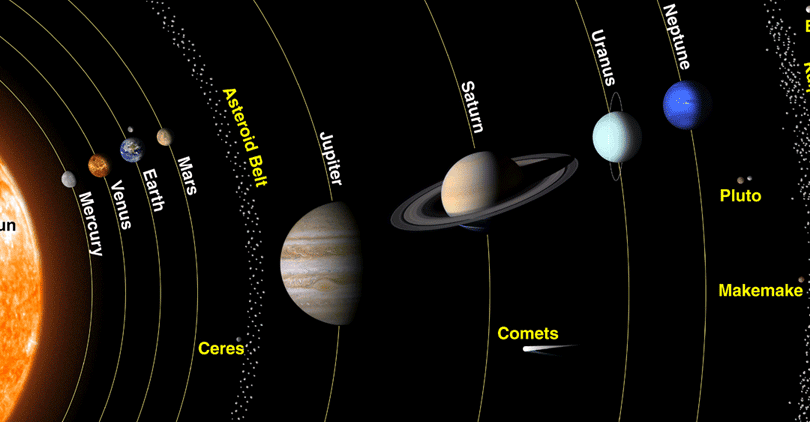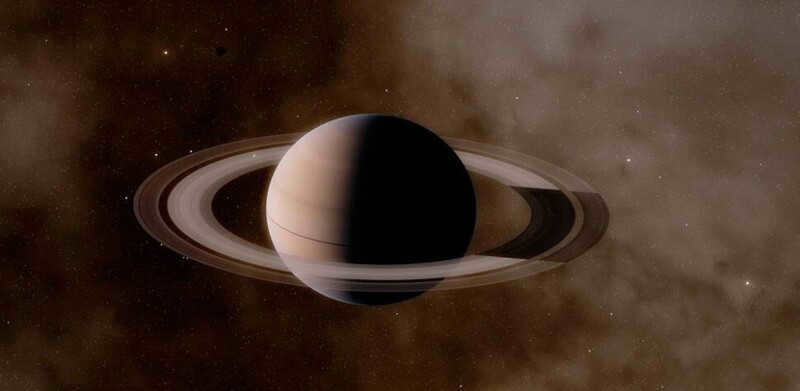
Rings of Saturn
The most captivating feature of Saturn is its magnificent rings. In fact, all gas giants possess rings, but Saturn’s rings are exceptionally brilliant, making them visible even through a basic telescope. Interestingly, it was Galileo who first laid eyes on these mesmerizing rings when he turned his telescope towards the night sky.
Located precisely above Saturn’s equator, these rings are composed of 99% water ice and are less than 1 kilometer in width. The smallest ring, discovered in 2009, has a radius of 67 thousand km (while Saturn’s equatorial radius is 60,268 km). Furthermore, the ring of Thebes, which was only recently identified, is situated at a distance of 4 million km from the center of the planet.
In 1921, there was a widespread rumor in the newspapers claiming that the rings of Saturn had vanished and their broken pieces were hurtling towards Earth. However, the truth is that during that year, the rings and Saturn itself were positioned in such a way that their edges were facing Earth, making them invisible to observers.
A celestial body with the potential for sustaining life
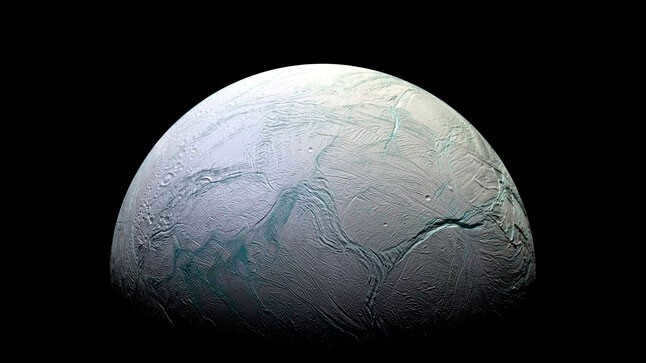
Saturn holds the record for having the highest number of satellites, with a total of 82 orbiting around it. Among these satellites, Enceladus has garnered the most attention from scientists due to its unique characteristics. This satellite is covered by a thick layer of ice, beneath which lies a vast water ocean. Data collected from various probes suggest that the temperature within this ocean can reach 0 degrees Celsius, and the salinity of the water is comparable to that of Earth’s World Ocean. Additionally, in 2018, the presence of complex macromolecules of organic matter on Enceladus was officially confirmed. These findings collectively indicate the potential for life to exist on this satellite. In fact, in 2011, it was officially declared that Enceladus offers the most favorable conditions for life, apart from our own planet, within the entire solar system.
Astonishing Discovery: Titan, Saturn’s Largest Moon, Holds Liquid Lakes
For centuries, scientists believed that Earth was the only celestial body in our solar system to possess liquid on its surface. However, a groundbreaking revelation in 1995 shattered this notion, proving that Titan, Saturn’s largest moon, is adorned with lakes, canals, and even seas! But here’s the twist – these bodies of liquid aren’t made up of water, but rather hydrocarbons. In fact, a staggering 76-79% of their composition is liquid ethane.
The presence of liquid on Titan’s surface can be attributed to the moon’s dense atmosphere, which is 1.5 times thicker than that of Earth. Titan truly is a colossal moon, boasting a radius of 2576 km, making it slightly larger than Mercury.
Saturn has a unique composition
Saturn is categorized as a gas giant, which means that it is predominantly made up of hydrogen (96%) and helium (3%). As a result, the majority of Saturn is comprised of its atmosphere. Within the depths of the atmosphere, the pressure rises, causing the gases to transition into a liquid state, forming an ocean-like layer. However, unlike Earth, there is no distinct boundary between this liquid layer and the rest of the atmosphere.
At even greater depths within Saturn, where the pressure reaches an astounding 3 million atmospheres, the liquid hydrogen undergoes a transformation and becomes metallic. Below this layer of metallic hydrogen lies a relatively small core (which is still 20 times more massive than Earth) composed of heavy elements such as silicon and metals.
With its composition being 96% hydrogen, Saturn possesses an extraordinarily low density, measuring at a mere 687 kg/m3. This value is 1.5 times lower than that of water, making Saturn the lightest planet in our solar system. Interestingly, due to its low density, Saturn’s free-fall acceleration is almost identical to that of Earth, despite Earth’s mass being 95 times smaller than Saturn’s.
A cloud in the shape of a hexagon
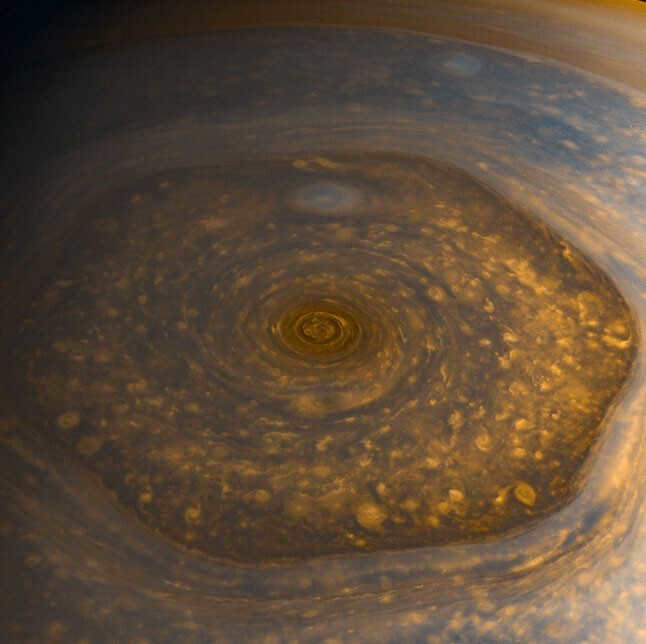
It is a common occurrence for cyclones and anticyclones on various planets, including Earth, to take on a circular shape. However, Saturn stands out with its unique discovery of a hexagonal vortex in the 1980s. This formation has proven to be remarkably stable and continues to persist to this day. In fact, its cross-sectional size spans an impressive 25,000 square kilometers, surpassing that of Earth. This distinctive hexagon is located at Saturn’s North Pole. Despite ongoing scientific research, there is still no definitive explanation for this phenomenon, although recent laboratory experiments have successfully replicated similar microvortices.
Saturn’s Unique Two-Faced Satellite
Japet, one of Saturn’s satellites, is truly unique. It possesses two distinct hemispheres that differ drastically in their appearance. The front hemisphere, known as the leading hemisphere, shines with a brilliant white glow, resembling a snowy surface. It reflects an impressive 60% of the light that falls upon it. On the other hand, the back hemisphere, referred to as the trailing hemisphere, is as dark as soot, reflecting a mere 3% of the light. This striking contrast results in Japet’s brightness in the night sky fluctuating by two star magnitudes at regular intervals.
The reason behind Japet’s two-faced nature lies in the accumulation of dust on one side of the satellite. Although the dust layer is relatively thin, measuring only a few tens of centimeters, it is enough to cause such a dramatic transformation in the satellite’s appearance.
Due to its low density and rapid rotation (completing one revolution every 10.5 hours), Saturn is the most oblate planet in the solar system. Its equatorial radius is 60268 km, while its polar radius is 54364 km, resulting in a difference of approximately 10%. In contrast, the Earth’s polar and equatorial radii differ by only 0.35%.
Rings around a satellite
There is a belief that Rhea, one of Saturn’s moons, could possibly possess its own set of rings. If this is indeed the case, Rhea would stand as the first and currently solitary moon to possess rings. Nonetheless, there is still a lack of conclusive evidence regarding their existence.
Thoroughly examined by the Cassini spacecraft.
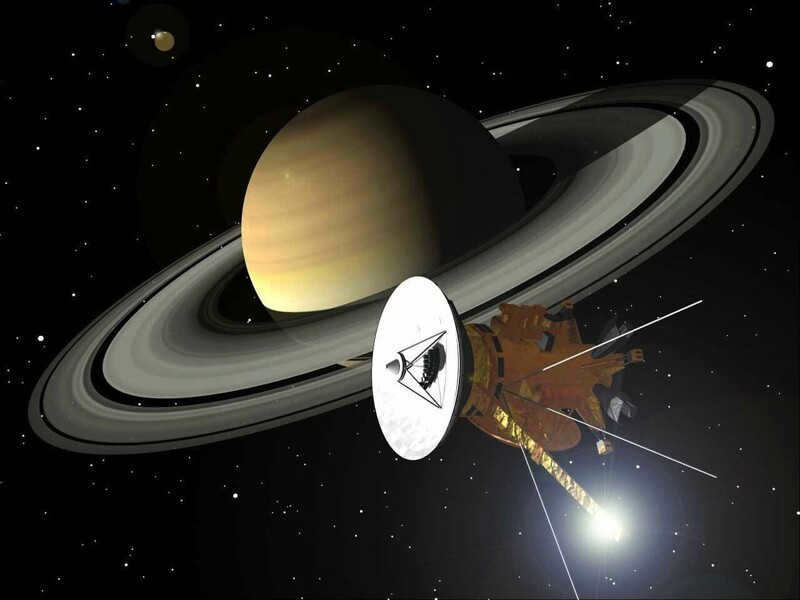
The rings of Saturn are its most prominent feature. While all giant planets have rings, Saturn’s rings are especially bright and can be observed with an amateur telescope. They were first discovered by Galileo, who was the first to use a telescope to observe the sky.
Located directly above Saturn’s equator, the rings are composed of 99% water ice and are less than 1 kilometer wide. The smallest ring has a radius of 67,000 kilometers, while the recently discovered Thebes ring is located 4 million kilometers from the planet’s center.
In 1921, there was a rumor that the rings had disappeared and their fragments were heading towards Earth. However, the rings were simply positioned in such a way that their edges were facing Earth, making them invisible during that time.
A satellite capable of supporting life
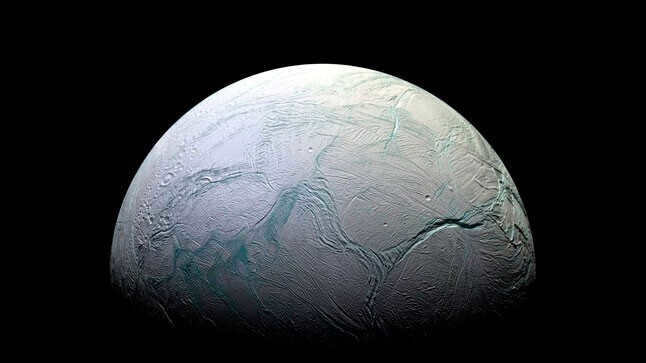
Saturn holds the record for having the largest number of satellites, with a total of 82 orbiting around it. Among these satellites, Enceladus has attracted significant attention from modern scientists. It is covered by a layer of ice that conceals a vast water ocean beneath. Data collected from various probes have revealed that the temperature within the ocean can drop to 0 degrees Celsius, and the salinity of the water is comparable to that of the Earth’s World Ocean. Moreover, in 2018, scientists confirmed the presence of complex macromolecules of organic matter on Enceladus. All of these findings strongly suggest the possibility of life existing on this satellite. In fact, in 2011, it was officially declared that the conditions on Enceladus, aside from Earth, are the most suitable for the existence of life within our solar system.
For a significant period of time, it was widely believed that no celestial body within the solar system, apart from Earth, possessed liquids on its outer layer. However, in the year 1995, conclusive evidence was presented to demonstrate that Titan, the largest moon of Saturn, boasts lakes, canals, and even seas! Nevertheless, these bodies of liquid are not comprised of water, but rather consist of hydrocarbons. Approximately 76-79% of their composition is constituted by liquid ethane.
The presence of liquid on the outer layer of Titan can be attributed to the fact that this moon encompasses an atmosphere that possesses a density 1.5 times greater than that of Earth’s. Titan is an exceedingly sizable moon. Its radius measures 2576 km, thus indicating that it is slightly larger than Mercury.
Saturn’s Surface is Nonexistent
Saturn is categorized as a colossal gas giant. This classification indicates that it primarily consists of gases, with hydrogen making up about 96% and helium 3%. Consequently, the majority of Saturn is composed of its atmosphere. In the deeper regions of the atmosphere, the pressure intensifies, causing the gases to transition into a liquid ocean. However, there is no distinct boundary separating the ocean and the atmosphere, similar to Earth.
Beneath the layers of Saturn’s atmosphere lies an incredibly high-pressure environment, where the pressure reaches 3 million atmospheres, causing liquid hydrogen to transform into a metallic state. Below this layer of metallic hydrogen lies a relatively small core (although it is still 20 times more massive than Earth) composed of dense elements such as silicon and metals.
Low density
With 96% of its composition being hydrogen, Saturn possesses an extremely low density of only 687 kg/m3. This value is 1.5 times lower than the density of water, making Saturn the lightest planet in the solar system. Interestingly, due to its low density, Saturn’s free-fall acceleration is almost identical to Earth’s, despite Earth having a mass 95 times less than Saturn.
Saturn is the sixth planet from the Sun and the second largest planet in the Solar System, trailing only behind Jupiter. Alongside Jupiter, Uranus, and Neptune, Saturn is categorized as a gas giant. The planet takes its name from the Roman god Saturn, who corresponds to the Greek deity Kronos (the Titan and father of Zeus) and the Babylonian god Ninurta. The symbol associated with Saturn is the sickle (Unicode: ♄).
Saturn consists primarily of hydrogen, with small amounts of helium and traces of water, methane, ammonia, and solid materials. The inner region contains a compact core made of rock and ice, which is covered by a thin layer of metallic hydrogen and an outer layer of gas. The planet’s outer atmosphere appears tranquil and peaceful, although it occasionally exhibits some long-lasting features. Wind speeds on Saturn can reach up to 1800 km/h in certain areas, which is significantly higher compared to Jupiter, for instance. Saturn possesses a planetary magnetic field that is moderately powerful, falling between the strength of Earth’s magnetic field and the mighty field of Jupiter. The magnetic field of Saturn extends 1 million kilometers in the direction of the Sun. Voyager 1 detected the shock wave at a distance of 26.2 radii of Saturn from the planet itself, while the magnetopause is located at a distance of 22.9 radii.
Saturn boasts a remarkable system of rings made up primarily of frozen particles, with smaller quantities of rock and dust. The planet is circled by a total of 62 known moons. The largest of these is Titan, which is also the second largest moon in the entire solar system (just behind Ganymede, a moon of Jupiter). In fact, Titan is even bigger than the planet Mercury and is the only moon in the solar system to possess a dense atmosphere.
Physical characteristics
Orbital characteristics
Saturn is located at an average distance of 1,433,531,000 kilometers (9.58 a.u.) from the Sun [2]. It takes approximately 10,759 days (or about 29.5 years) for Saturn to complete one orbit around the Sun, with an average speed of 9.69 km/s. Interestingly, Saturn and Jupiter are in almost exact 2:5 resonance. Due to the eccentricity of Saturn’s orbit, which is 0.056, there is a difference of 162 million kilometers in the distance between Saturn and the Sun at perihelion and aphelion [2].
Key Facts
Saturn is classified as a gas giant planet, meaning it is primarily composed of gases and lacks a solid surface.
The planet has a equatorial radius of 60,300 kilometers and a polar radius of 54,000 kilometers. Saturn is unique among the planets in our solar system due to its high compression. Despite having a mass 95 times greater than Earth, Saturn has an average density of only 0.69 g/cm³, making it the only planet in our solar system with an average density lower than that of water.
One interesting feature of Saturn is its relatively fast rotation. The planet completes one full rotation on its axis in just 10 hours, 34 minutes, and 13 seconds.
The upper atmosphere of Saturn is primarily composed of 93% hydrogen and 7% helium (in comparison to Jupiter’s atmosphere, which contains 18% helium). Additionally, there are trace amounts of methane, water vapor, ammonia, and various other gases present. Notably, the ammonia clouds found in the upper region of Saturn’s atmosphere are more intense than those found on Jupiter.
As per the reports from Voyagers, Saturn is experiencing strong gusts of wind, with the instruments recording air velocities of 500 m/s. These winds primarily blow towards the east, following the planet’s axial rotation. As the winds move away from the equator, their intensity gradually decreases, while westerly atmospheric currents start to emerge. Various data suggests that these winds are not limited to the upper cloud layer, but rather extend inward by at least 2,000 km. Furthermore, measurements from Voyager-2 indicate that the winds in the southern and northern hemispheres exhibit symmetry around the equator. It is hypothesized that these symmetrical flows are somehow interconnected beneath the visible atmospheric layer.
Occasionally, stable formations emerge in Saturn’s atmosphere, manifesting as incredibly powerful hurricanes. Similar occurrences have been witnessed on other gas planets within our solar system (such as the Great Red Spot on Jupiter and the Great Dark Spot on Neptune). Approximately once every 30 years, a massive “Great White Oval” materializes on Saturn, with the most recent sighting occurring in 1990 (although smaller storms occur more frequently).
One of Saturn’s atmospheric phenomena, known as the “Giant Hexagon,” still remains partially mysterious. This stable structure takes the form of a regular hexagon with a diameter of 25,000 kilometers, encompassing the planet’s north pole.
The atmosphere of Saturn has also been found to contain intense thunderstorms, auroras, and ultraviolet hydrogen radiation. In fact, on August 5, 2005, the Cassini spacecraft captured radio waves generated by lightning.
Structure within Saturn
In the depths of Saturn’s atmosphere, both pressure and temperature increase, causing hydrogen to gradually transition into a liquid state. Approximately 30,000 kilometers beneath the surface, the hydrogen transforms into a metallic form, resulting in an immense pressure of about 3 million atmospheres. The flow of electrical currents within this metallic hydrogen generates a magnetic field, although it is significantly weaker compared to Jupiter’s. Positioned at the planet’s core lies a massive center composed of dense materials, such as rock, iron, and potentially ice, which can reach up to 20 times the mass of Earth. For a visual representation of Saturn’s internal structure, please refer to the accompanying diagram.
Saturn investigation
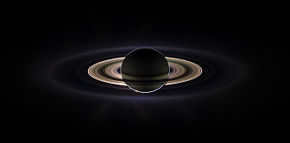
Saturn is among the five planets in our solar system that can be easily seen with the naked eye from Earth. At its peak, Saturn’s brightness surpasses that of the first magnitude star.
When Galileo Galilei initially viewed Saturn through a telescope in 1609-1610, he observed that Saturn did not appear as a solitary celestial object, but rather as three bodies closely positioned near each other. He hypothesized that these were two sizable “companions” (satellites) of Saturn.
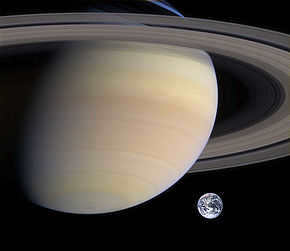
“Companions” (satellites) of Saturn were observed by Galileo in 1610. Two years later, Galileo conducted the same observations and was surprised to find no satellites.
In 1659, Huygens, using a more advanced telescope, made a remarkable discovery. He found that the “companions” were actually a thin, flat ring encircling the planet, but not touching it. Huygens also identified Titan, the largest satellite of Saturn. From 1675 onwards, Cassini dedicated his studies to Saturn. He observed that the ring consisted of two distinct rings with a visible gap – known as the Cassini gap, and he also discovered several other large satellites of Saturn.
Back in 1979, Saturn was explored up close for the very first time by the Pioneer 11 spacecraft. This historic event was followed by the Voyager 1 and Voyager 2 missions in 1980 and 1981. These missions were instrumental in discovering Saturn’s magnetic field and studying its magnetosphere, as well as observing storms in the planet’s atmosphere. Additionally, the spacecraft were able to capture detailed images of the ring structure and determine their composition.
Fast forward to the 1990s, and the Hubble Space Telescope took over the task of studying Saturn, its satellites, and its rings. Thanks to its long-term observations, a wealth of new information was gathered that was not available to the earlier missions. This ongoing research has further deepened our understanding of this magnificent planet.
The Cassini-Huygens mission was launched in 1997 with the goal of studying Saturn and its system. After a seven-year journey, the spacecraft reached Saturn on July 1, 2004, and successfully entered orbit around the planet. The primary objectives of this mission, which is expected to last for at least four years, include investigating the structure and dynamics of Saturn’s rings and moons, as well as studying the atmosphere and magnetosphere of the planet. Additionally, a special probe named “Huygens” was deployed from the spacecraft and descended to the surface of Saturn’s moon Titan using a parachute.
As of February 2010, there are 62 known satellites orbiting Saturn. Of these, 12 were identified by spacecraft missions including Voyager 1 (1980), Voyager 2 (1981), and Cassini (2004-2007). With the exception of Hyperion and Thebe, most of these satellites have synchronized rotation, always facing Saturn on the same side. The rotation patterns of the smallest satellites remain unknown.
In 2006, a group of scientists led by David Jewitt from the University of Hawaii made an exciting discovery using the Japanese Subaru telescope in Hawaii. They identified 9 new satellites orbiting Saturn.
All of these newly discovered satellites are classified as “irregular satellites” due to their elongated elliptical orbits. It is believed that these satellites did not form alongside the planet but were instead captured by Saturn’s gravitational field.
Since 2004, Jewitt’s team has discovered a total of 21 satellites orbiting Saturn.
Titan is the largest of the satellites. Scientists hypothesize that the conditions on this satellite resemble those that existed on Earth 4 billion years ago, during the emergence of life.
Saturn’s Rings
All four gas giants are now known to have rings, but Saturn’s rings are the most beautiful and visible. The rings are tilted at an angle of about 28° to the ecliptic plane. As a result, their appearance from Earth can vary depending on the relative positions of the planets: they may appear as complete rings or as seen “from the edge”.
According to Huygens’ theory, the rings are not a solid mass, but rather composed of billions of tiny particles in orbit around the planet.
There exists a set of three primary rings and an additional, slimmer ring. Collectively, these rings possess the ability to reflect a greater amount of light compared to the actual disk of Saturn. The three primary rings are commonly recognized by utilizing the initial characters of the Latin alphabet. The central, broadest, and most luminous ring is known as Ring B and is separated from the larger outer Ring A by the Cassini slit, which spans approximately 4000 km in width. This particular slit contains the thinnest and nearly transparent rings. Within Ring A, one can find a delicate slit called the Encké divide. Lastly, Ring C, which is situated even closer to the planet than Ring B, is almost completely transparent.
Saturn’s rings have a remarkably thin structure. Measuring approximately 250,000 km in diameter, they are not even a kilometer thick (although there are interesting mountains on the surface of the rings [4]). Despite their impressive appearance, the amount of material that comprises the rings is incredibly small. If consolidated into a single monolith, its diameter would not exceed 100 kilometers.
The images captured by the probes reveal that the rings are actually composed of numerous rings alternating with gaps; the pattern resembles the grooves on vinyl records. The particles that form the rings are mostly a few centimeters in size, but occasionally there are larger objects measuring several meters. Very rarely, these particles can reach sizes of 1-2 kilometers. The particles appear to be primarily composed of ice or rock covered with ice.
The alignment between the rings and the planet’s satellites is fully consistent. In fact, certain satellites, known as “shepherd satellites”, have a role in maintaining the rings’ positions. For instance, Mimas is responsible for the absence of matter in Cassini’s gap, while Pan resides within Enck’s separation band.
The exact origin of Saturn’s rings remains somewhat uncertain. It is possible that they formed simultaneously with the planet. However, the rings represent an unstable system, and the material they consist of undergoes periodic replacement, likely due to the destruction of some of the smaller satellites.
Fascinating tidbits
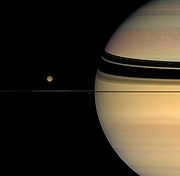
- Saturn does not have a solid surface. It is the planet with the lowest average density in our solar system. The planet is primarily made up of hydrogen and helium, which are the lightest elements in space. In fact, Saturn’s density is only 0.69 times the density of water. This means that if there was a large enough ocean, Saturn would actually float on its surface.
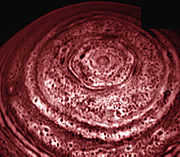
- The clouds on Saturn exhibit a remarkable and unique feature – a colossal hexagon shape. This extraordinary formation was first discovered by the Voyager spacecraft during its flybys near Saturn in the 1980s, and it remains a phenomenon unseen anywhere else in our solar system. While Saturn’s south pole, with its swirling hurricane, may appear peculiar, the north pole is even more extraordinary. Captured in an infrared image taken by the Cassini spacecraft in October 2006, the image showcases the perplexing cloud structure. Over the course of 20 years, the hexagon has demonstrated remarkable stability, as evidenced by the Voyager mission and subsequent observations. Fascinatingly, the rotating movies of Saturn’s north pole reveal the continuous preservation of this hexagonal cloud structure. While individual clouds on Earth can sometimes exhibit a hexagonal shape, Saturn’s cloud system stands out with its well-defined sides, each of almost equal length. In fact, within this hexagon, one could fit four Earths. Despite extensive research, a comprehensive explanation for this captivating phenomenon remains elusive.
- Unlike the ancient times, the existence of planet Neptune remained unknown until its discovery in 1846, as it cannot be observed with the naked eye.
- Despite being smaller than Uranus, Neptune is the smallest among the other giant planets, yet it possesses a greater mass.
- The atmosphere of Neptune is rich in methane, a compound that absorbs red light, resulting in its distinct blue appearance.
- Neptune experiences powerful winds and hurricanes, with the largest storm known as the Great Dark Spot resembling Jupiter’s Great Red Spot. This massive storm was initially detected by Voyager 2 and later disappeared from the Hubble telescope’s observations in 1994.
- Similar to other giant planets, Neptune boasts an impressive system of rings composed of icy particles and dust.
- Neptune emits 2.61 times more heat than it receives from the Sun. The cause of this phenomenon remains a mystery.
- Neptune is orbited by 14 satellites, with Triton being the largest among them. Triton’s mass accounts for 99.5% of the combined mass of all of Neptune’s satellites.
- Voyager 2 made its close flyby of Neptune on August 25, 1989, passing within a distance of 3,000 kilometers. No other terrestrial spacecraft have visited Neptune since then.
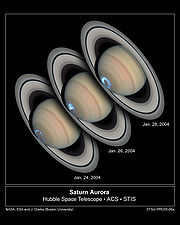
Scientists from the United Kingdom have made an exciting discovery in Saturn’s atmosphere – a previously unknown phenomenon called a polar glow. This fascinating occurrence takes the form of a ring surrounding one of the planet’s poles. (source: Atlas Aerospace)


- The appearance of the Northern Lights is a stunning natural phenomenon that occurs in the northern hemisphere near the North Pole. It is caused by the interaction of solar particles with the Earth’s magnetic field. The result is a beautiful display of colorful lights dancing across the sky. Satellites have captured incredible images of the Northern Lights, showcasing their vibrant colors and intricate patterns. It is a truly breathtaking sight that has fascinated humans for centuries.
Notes
Related information
References
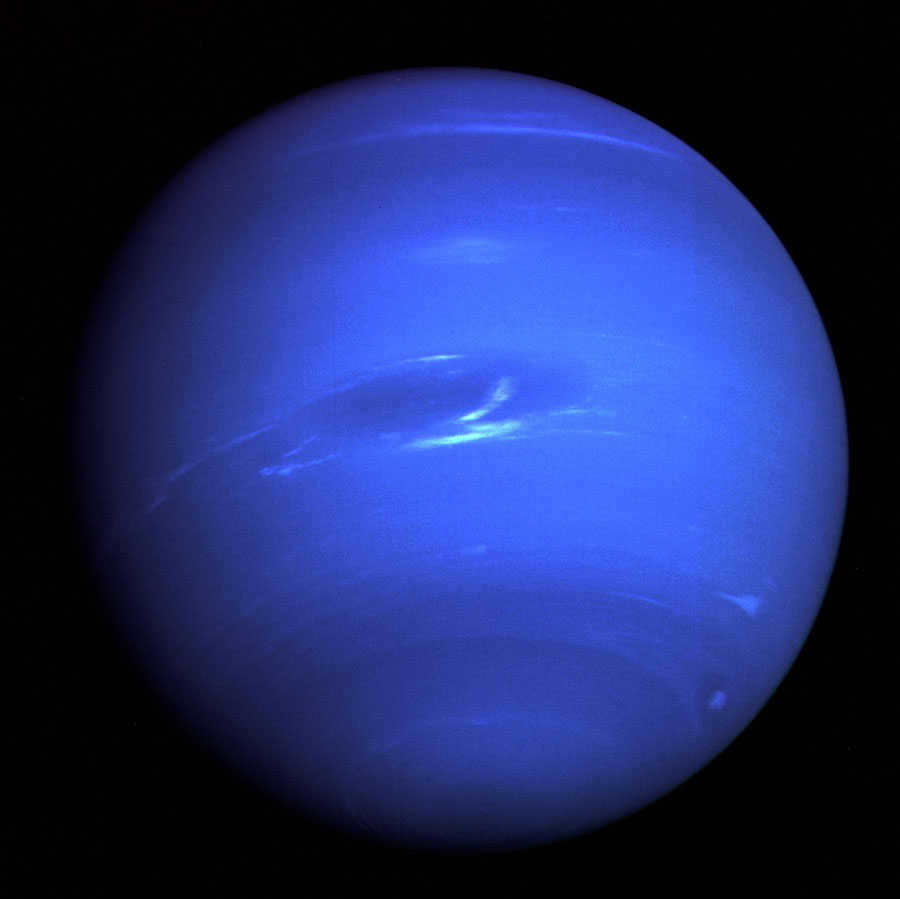
This photograph of Neptune was captured by Voyager 2 just five days before its groundbreaking encounter with the planet on August 25, 1989.
Neptune, a captivating azure behemoth situated on the fringes of our solar system, remained a clandestine enigma until the latter half of the 19th century.
The Discovery of History
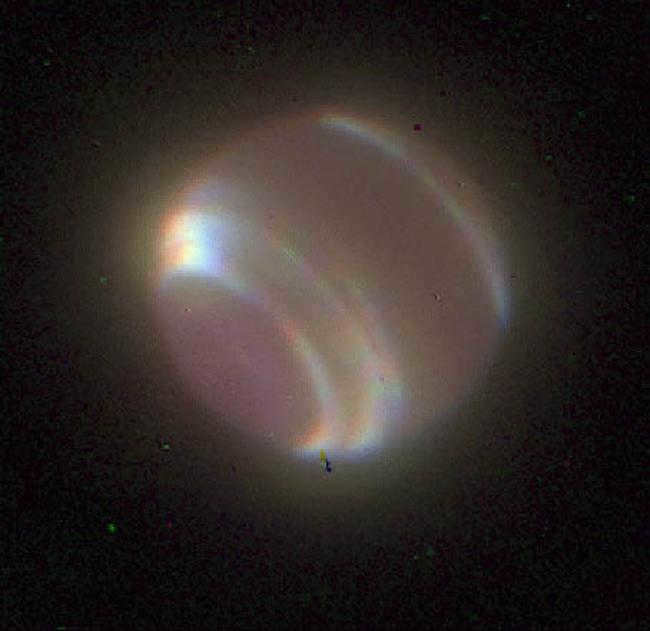
The discovery of Neptune, a remote planet hidden from plain sight, was made in the autumn of 1846. J.C. Adams was the first to speculate about the existence of this celestial body, as it seemed to exert a peculiar influence on the movement of Uranus. Adams presented his calculations and assumptions to the Royal Astronomer of Erie, who unfortunately disregarded them. Simultaneously, the Frenchman Leverrier was also investigating the irregularities in Uranus’ orbit and came to the conclusion that an unknown planet must be responsible. It became apparent that the findings of both independent studies were remarkably similar.
Orbit of Neptune
Following the removal of Pluto from the planetary lineup, Neptune emerged as the final, eighth member of the solar system. Its distance from the center measures a staggering 4.5 billion kilometers, taking a beam of light a full four hours to traverse. Classified as a gas giant, Neptune shares this distinction with Saturn, Uranus, and Jupiter. Due to its expansive orbit, a year on Neptune spans 164.8 Earth years, while a day lasts less than 16 hours. The planet’s trajectory around the Sun is nearly circular, with an eccentricity of 0.0112.
The configuration of the planet
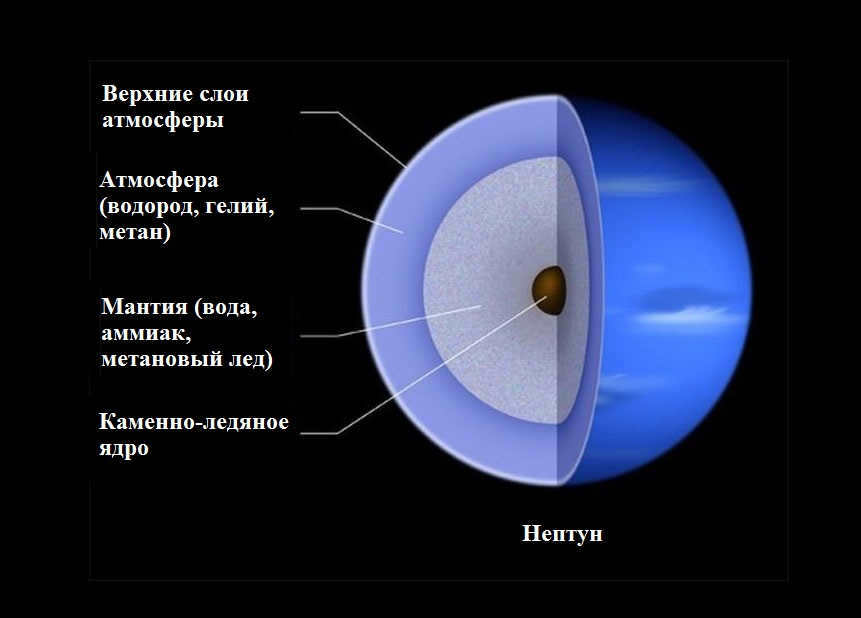
Theoretical calculations have led to the development of a mathematical model that describes the structure of Neptune. At the center of this planet lies a solid core, which is comparable in mass to that of Earth. The core is primarily composed of iron, silicates, and nickel. Surrounding the core is a surface that appears as a thick mixture of ammonia, water, and methane ice, with no distinct boundary separating it from the atmosphere. Despite the high internal temperature of the core, which can reach up to 7000 degrees, the frozen surface remains intact due to the immense pressure. The mass of Neptune is 17 times greater than that of Earth, measuring at 1.0243×10 to the power of 26 kilograms.
The atmosphere and powerful winds
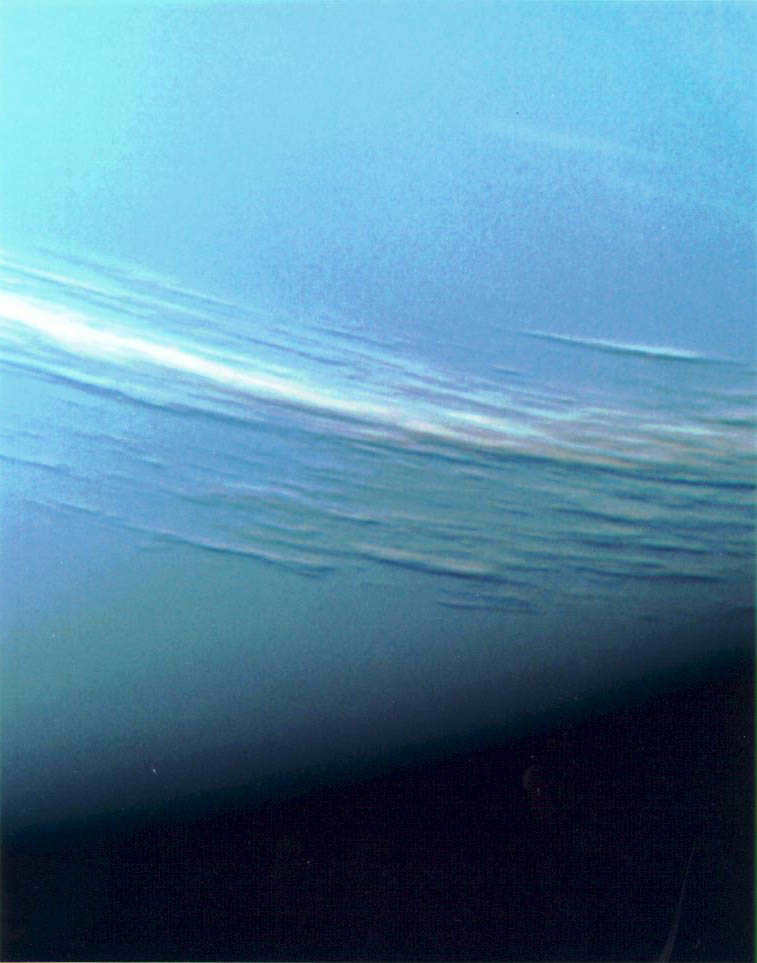
The gas shell of Neptune consists mainly of hydrogen (82%), helium (15%), and methane (1%), which is a typical composition for gas giants. The temperature on the hypothetical surface of Neptune is a frigid -220 degrees Celsius. The lower atmosphere of Neptune is adorned with clouds composed of methane crystals, hydrogen sulfide, ammonia, or ammonium sulfide. These icy particles contribute to the planet’s distinctive blue glow, although this phenomenon is only partially understood. Some scientists speculate that an unknown substance may be responsible for the bright blue coloration.
The winds on Neptune are incredibly powerful, with an average speed of 1000 km/h and hurricane-force gusts reaching up to 2400 km/h. Interestingly, these winds move in the opposite direction of the planet’s rotation. One puzzling observation is that storms and winds on Neptune seem to intensify as the distance between the planet and the Sun increases, a phenomenon that has yet to be fully explained.
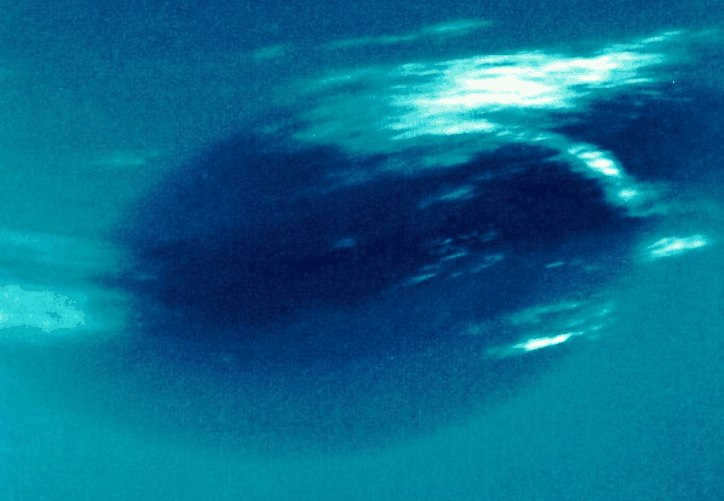
An enormous dark mark has been sighted on the surface of Neptune, thanks to the Voyager 2 spacecraft and the Hubble telescope. This incredible phenomenon, known as the Great Dark Spot, is essentially a colossal hurricane that races across the planet at a staggering speed of 1000 km/h. Interestingly, similar whirlwinds materialize and vanish in various locations on Neptune.
Magnetosphere
The giant’s magnetic field has gained significant strength, relying on its conductive liquid mantle. The magnetosphere’s shape is constantly changing due to the rotation of the planet, as evidenced by the 47-degree shift of its magnetic axis in relation to the geographic axis. This powerful shield is able to deflect and reflect the energy emitted by the solar wind.
Satellites of Neptune
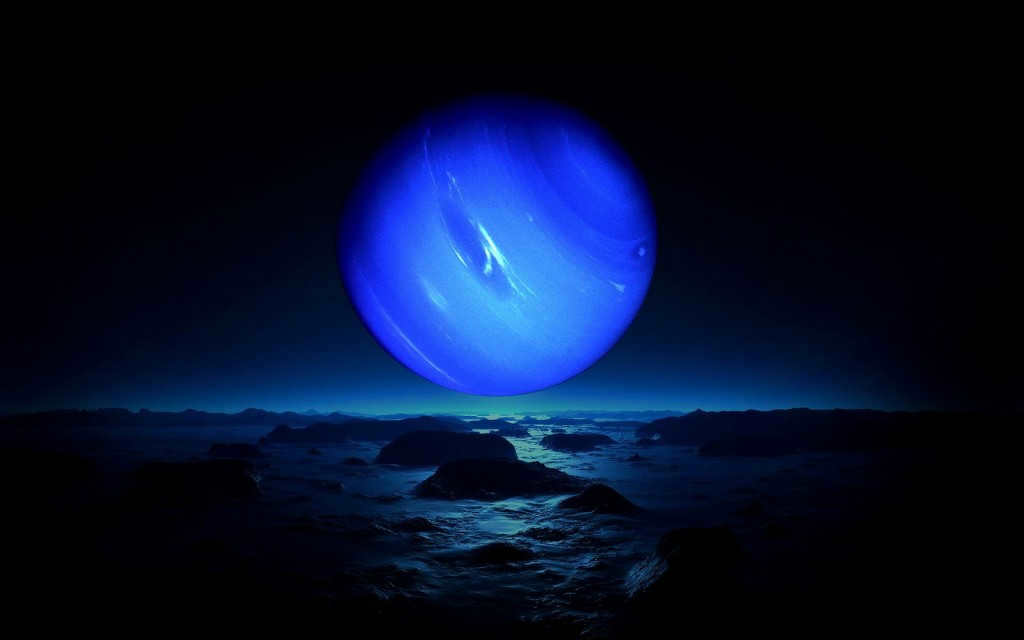
Artist’s rendering of the view of Neptune taken from the Triton satellite
One month after the exciting discovery of Neptune, the first satellite, Triton, was observed. It is estimated that Triton’s mass makes up 99% of the entire satellite system. Scientists believe that Triton may have been captured from the Kuiper belt, a vast region filled with objects ranging in size from small satellites to ones as large as Pluto, or even larger. Beyond the Kuiper Belt lies the Oort Cloud, which is the source of comets and extends almost halfway to the nearest star.
Triton is one of the three moons in our solar system that possesses an atmosphere, and it is the only one with a spherical shape. Neptune has a total of 14 celestial bodies in its company, all of which are named after the lesser gods of the deep sea.
Rings of Neptune
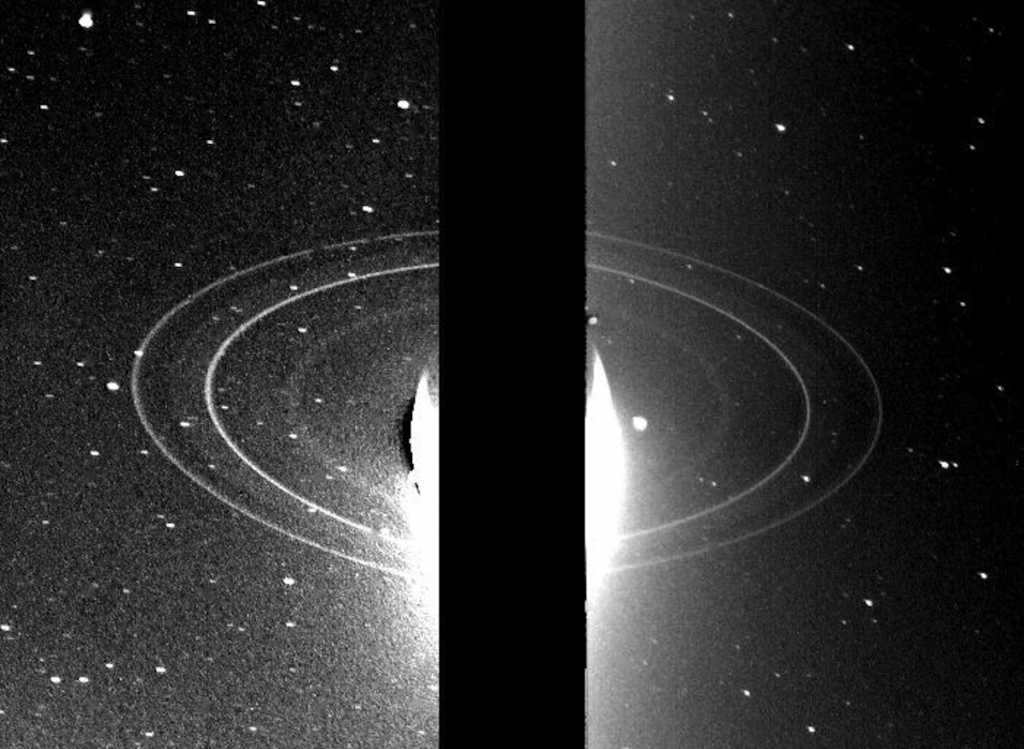
Ever since the planet’s discovery, there has been speculation about the existence of a ring system, but no concrete evidence was found to confirm this theory. It wasn’t until 1984 that a bright arc was observed at an observatory in Chile. The other five rings were subsequently discovered through the research conducted by the Voyager-2 spacecraft. These formations have a dark hue and do not reflect sunlight. They were named after the individuals who played a role in the discovery of Neptune: Halle, Leverrier, Argo, Lassel, and the most distant and peculiar one was named after Adams. This particular ring is composed of separate wishbone-shaped structures that were originally expected to merge into a single entity, but never did. One possible explanation for this anomaly is believed to be the gravitational influence of undiscovered satellites. One of the formations remains unnamed.
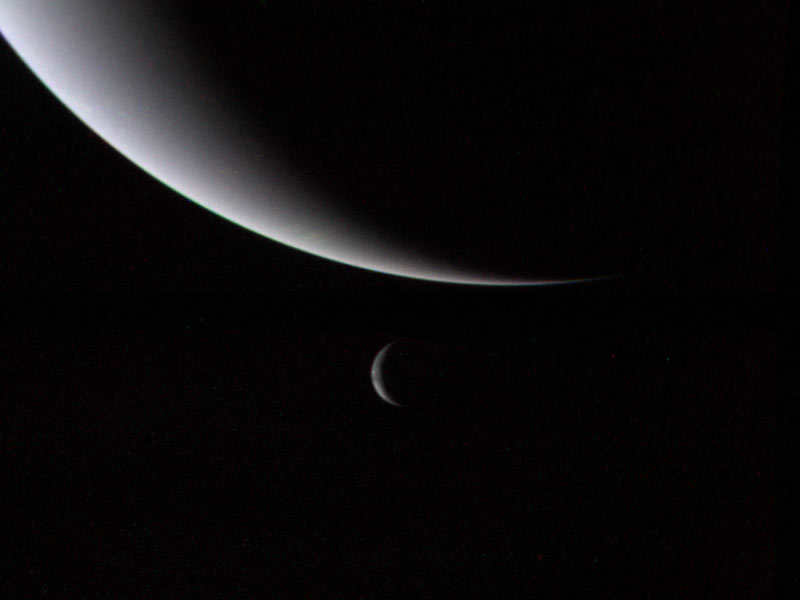
Due to its vast distance from Earth and unique position in space, Neptune poses a challenge when it comes to observing the planet. The introduction of large telescopes equipped with advanced optics has broadened scientists’ ability to study Neptune. Our understanding of the planet is primarily derived from data collected during the Voyager 2 mission. This distant, blue planet resides on the outskirts of our known universe, shrouded in enigma and holding countless secrets that remain largely undiscovered.
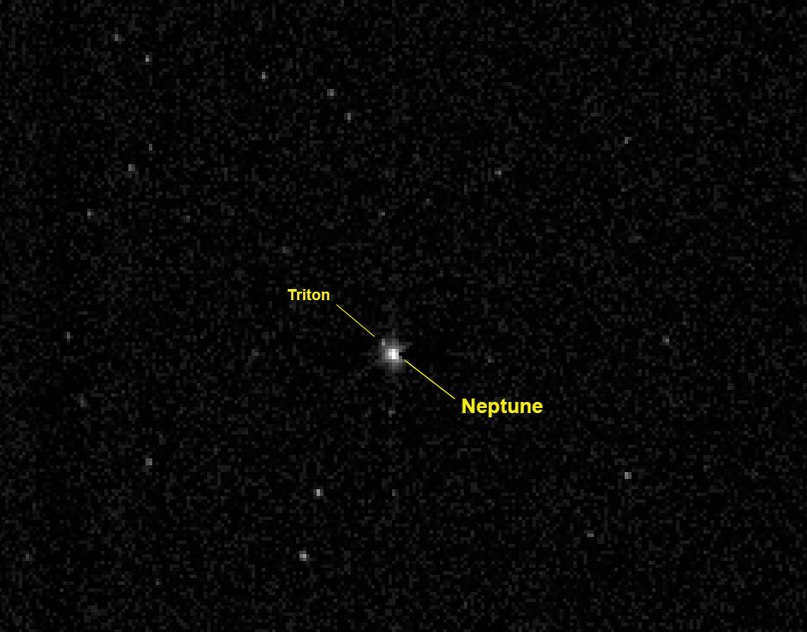
The New Horizons spacecraft successfully photographed Neptune and its moon Triton on July 10, 2014. This remarkable image was captured from an incredible distance of 3.96 billion kilometers away.
Neptune in Pictures
The images taken by Voyager 2 of Neptune and its moons are often overlooked. One of the most captivating features of Neptune is its massive moon Triton, which is similar in size and density to Pluto. There is evidence to suggest that Triton may have been captured by Neptune, as it orbits the planet in a retrograde motion (clockwise). The gravitational interaction between Triton and Neptune generates heat, keeping Triton geologically active. Its surface is marked by numerous craters.
Rings of Neptune
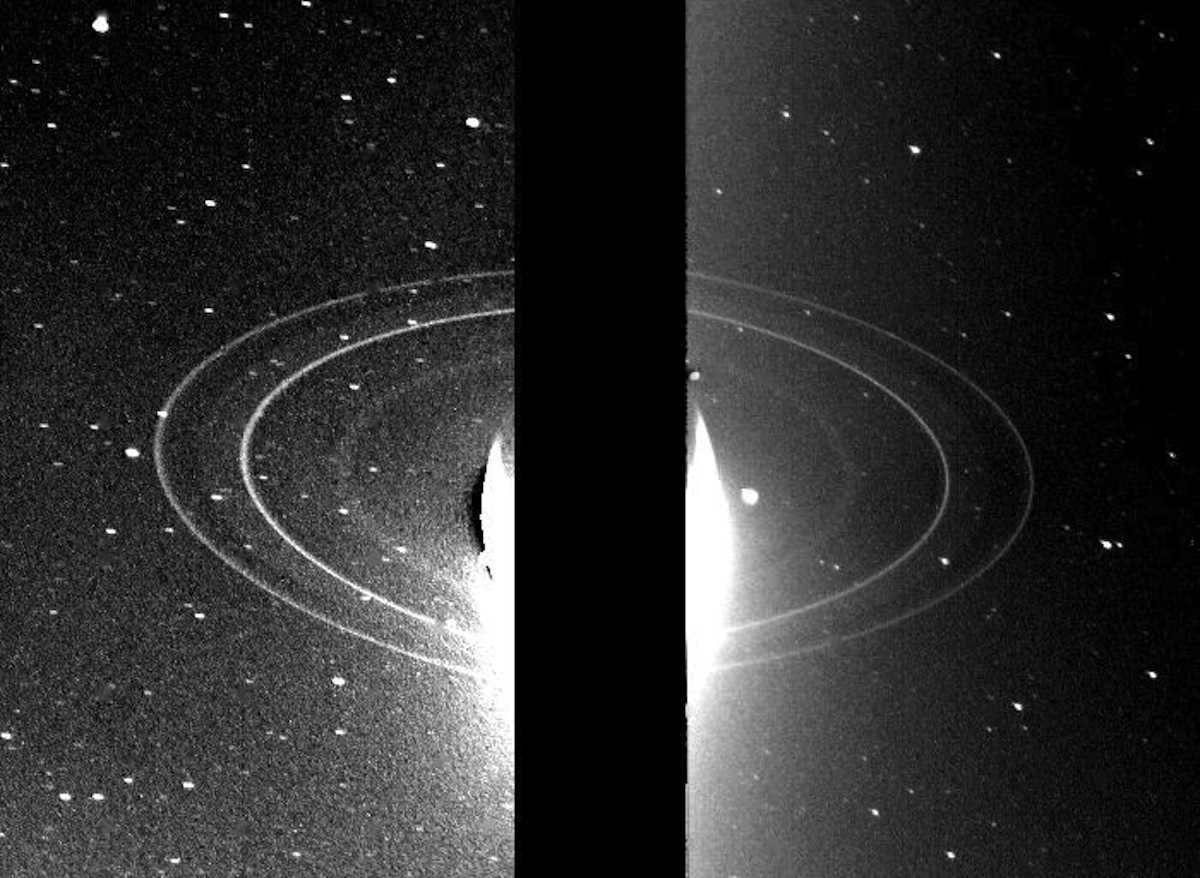
The rings of Neptune are barely noticeable and extremely difficult to see from our planet. The photograph captured by Voyager 2 shows the rings when they were illuminated by the Sun, although the image is heavily overexposed due to a 10-minute exposure time.
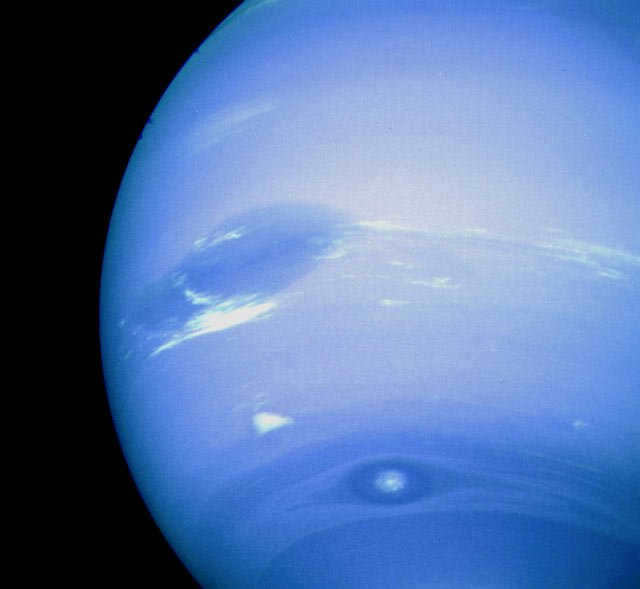
Despite being located farthest away from the Sun, Neptune boasts incredibly dynamic weather patterns, featuring the most powerful winds in our solar system. The image showcases the now-vanished “Great Dark Spot,” offering a glimpse into the rapid changes occurring on this remote planet.
The most up-to-date and comprehensive map of Triton
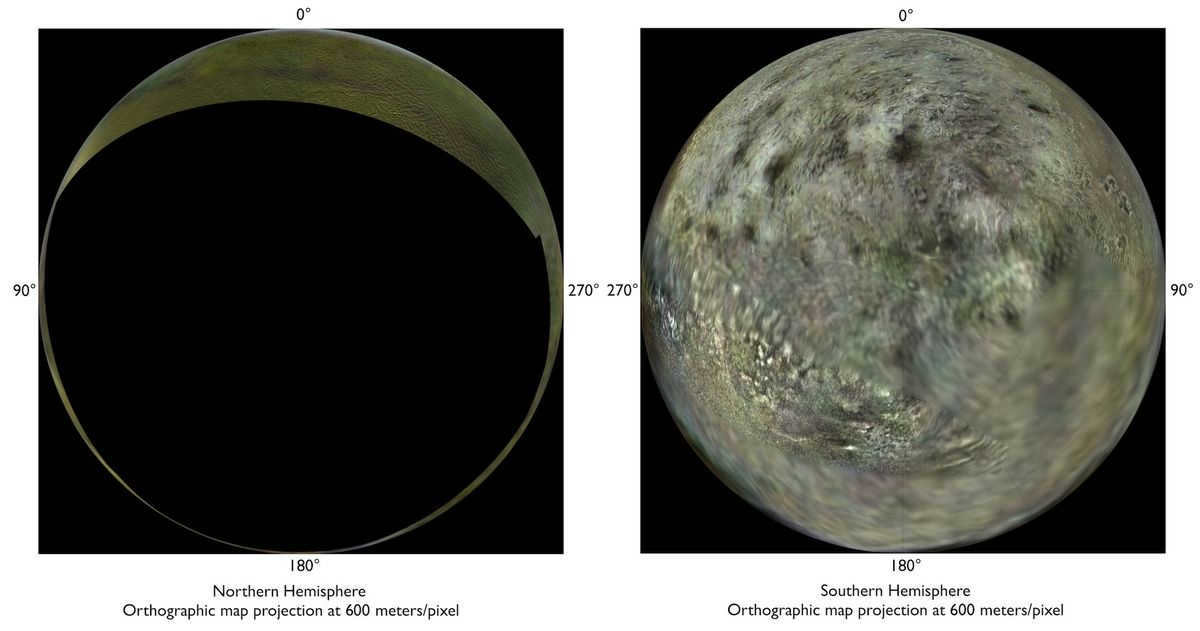
Paul Schenk, an expert from the Lunar and Planetary Institute in Houston, USA, has utilized previously collected data from the Voyager mission to generate a more detailed representation. The outcome is a comprehensive map of both the northern and southern hemispheres, although a portion of the Northern Hemisphere is missing due to being in shadow at the time of the spacecraft’s flyby.
An animated visualization of the Voyager 2 spacecraft’s flyby of Triton in 1989 is also available. The flyby occurred when a significant portion of Triton’s northern hemisphere was in shadow. The fast velocity of the Voyager spacecraft and Triton’s slow rotation allowed for observation of only one hemisphere.
The geysers of Triton
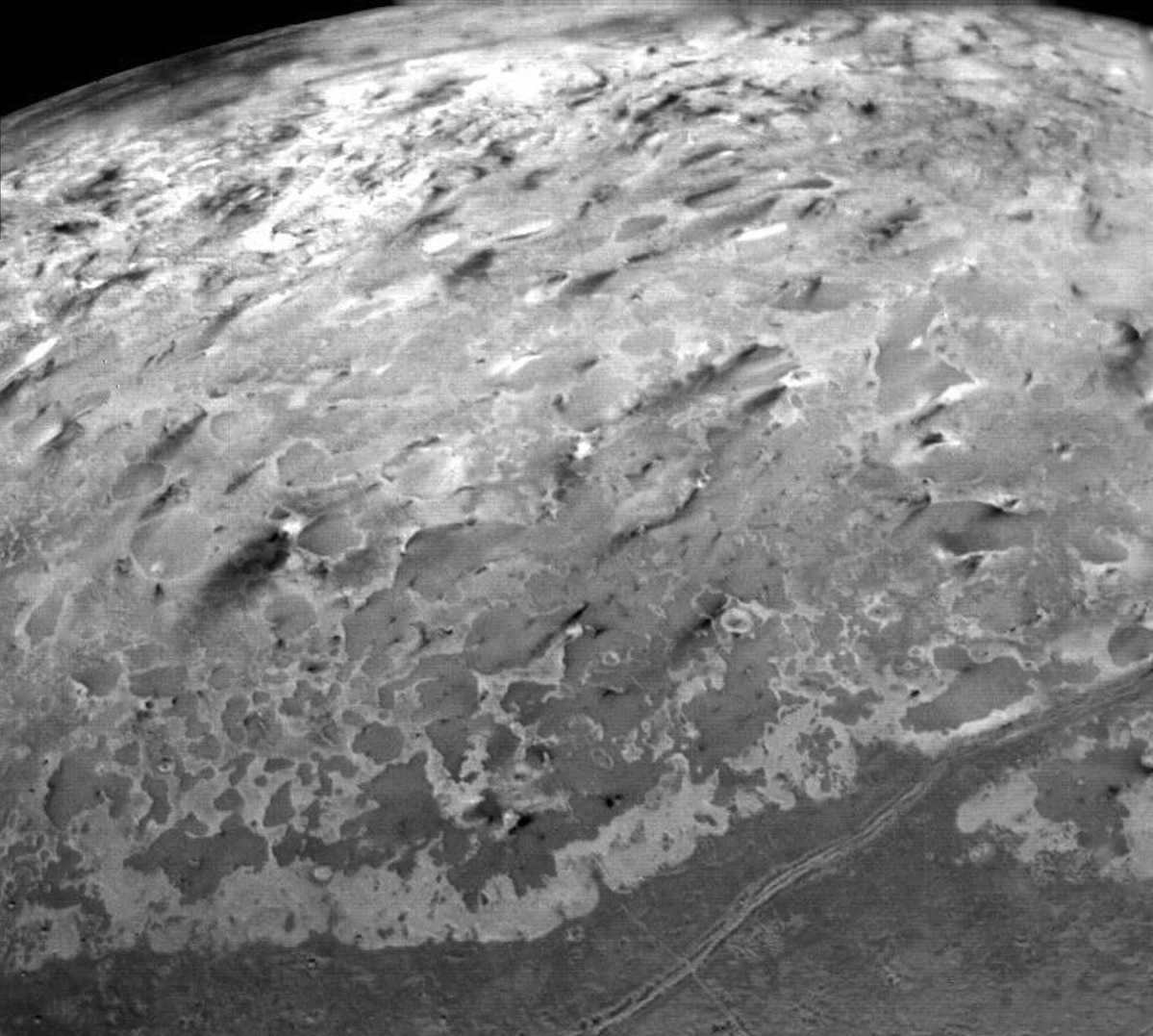
Geysers have been observed on the surface of the moon.
When Voyager 2 passed by Triton, it made two unexpected discoveries. Firstly, there is a notable absence of craters on the moon, suggesting that its surface is relatively young, estimated to be around 10 million years old. This makes it geologically very new. Secondly, Voyager detected a unique phenomenon where gases heated by the Sun erupted from the moon’s surface, forming clouds of fine dust that were subsequently scattered by the moon’s thin atmosphere.
An artist’s rendering of the surface of Triton as seen from Neptune.
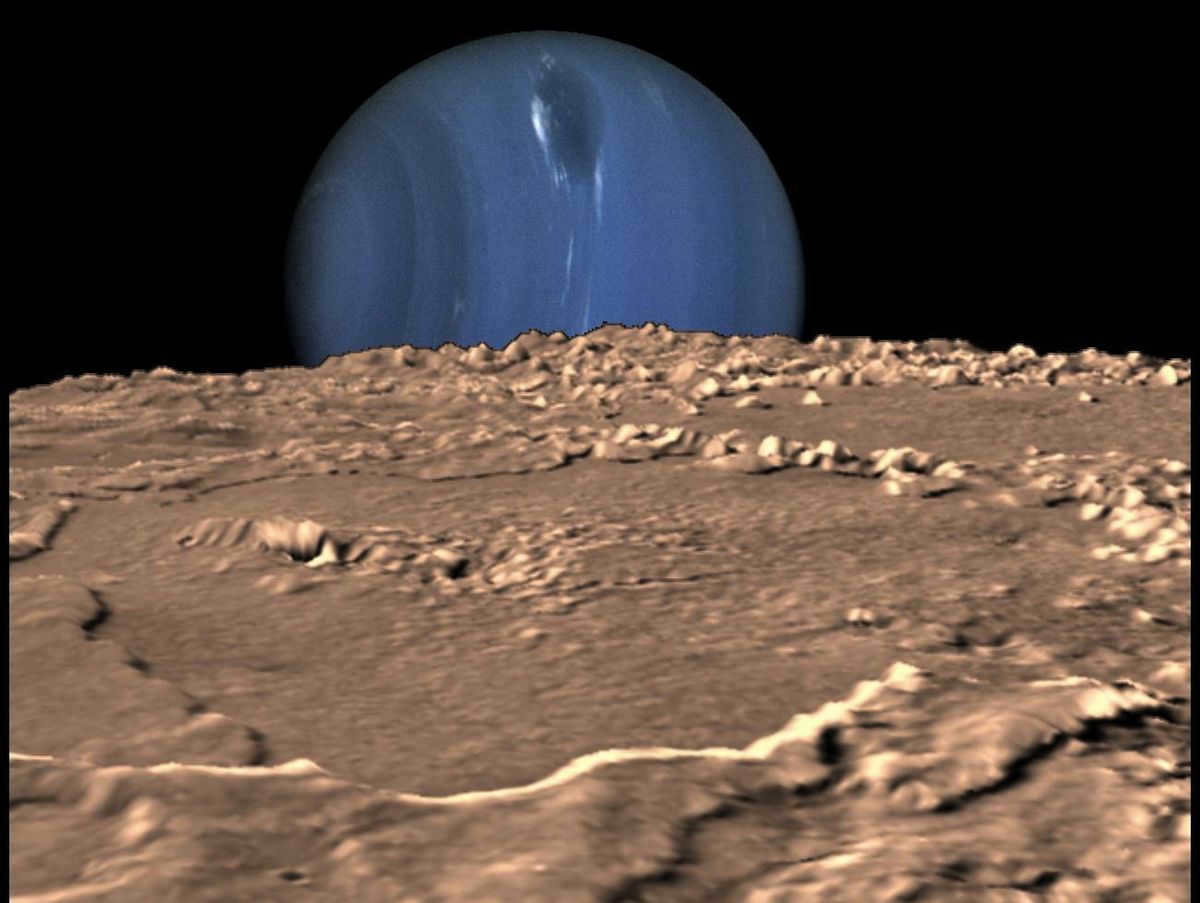
An artist’s rendering depicts the view of Neptune from the surface of Triton.
This image is a combination of two photographs captured by Voyager. The presence of smooth plains suggests that Triton’s surface has undergone changes due to icy volcanoes.
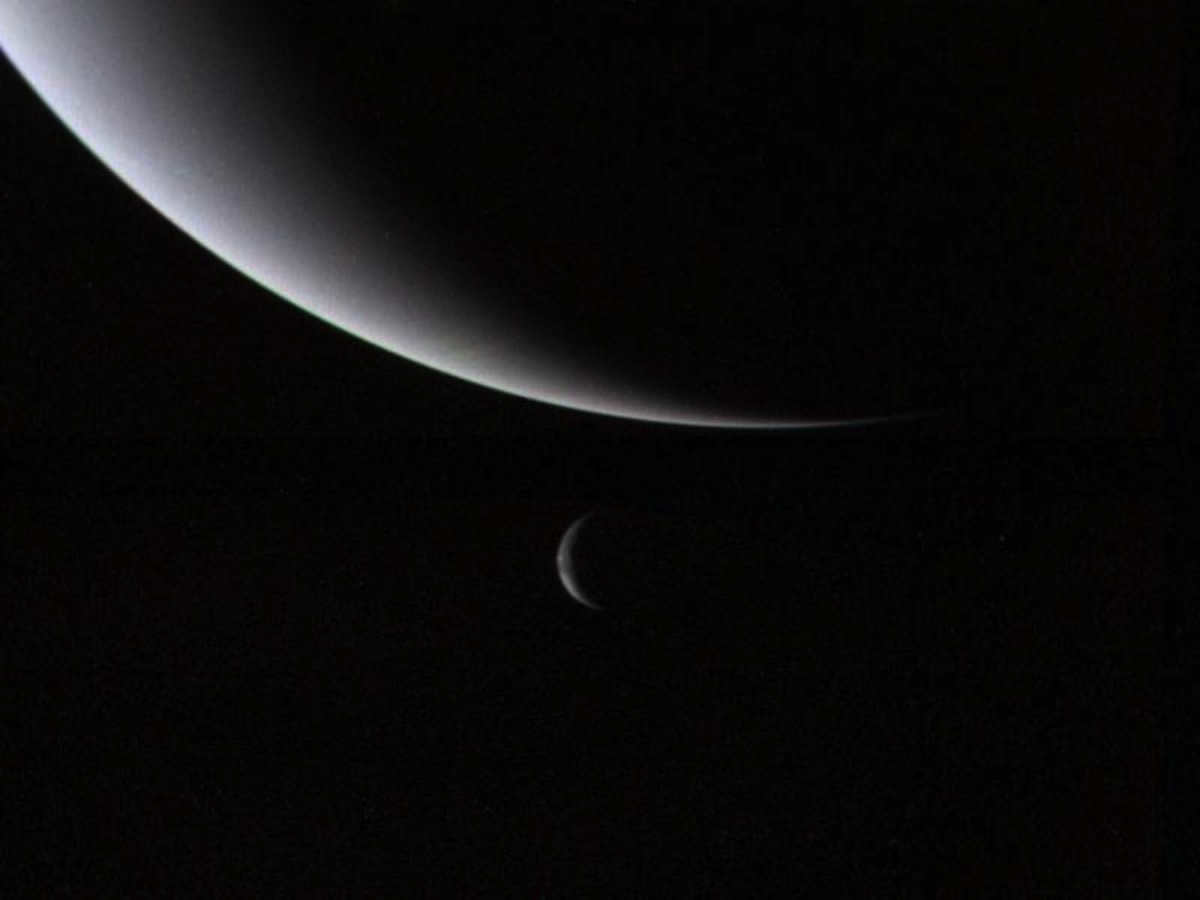
The crescents of Neptune and Triton.
After encountering Neptune, Voyager 2 captured a final image of the planet, revealing the beautiful crescents of Neptune and its moon Triton.
Neptune, a gas giant like Jupiter, Saturn, and Uranus, possesses several unique characteristics. It is a distinct world, unlike any other. Discovered in 1846 through mathematical calculations, Neptune has completed only one orbit around the Sun since then, marking the completion of its first year and the beginning of its second.
Although Neptune’s brightness is merely 8m, making it invisible to the naked eye, it can still be observed with a small telescope or quality binoculars. At night, it can be located in the constellation Aquarius.
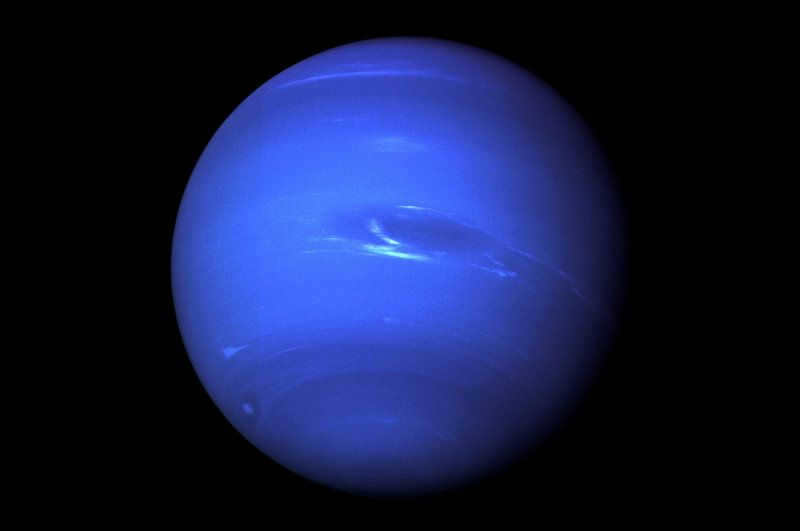

Snapshot of Planet Neptune taken by Voyager 2.
The Discovery of Planet Neptune
The discovery of this planet has an interesting and unusual history. It was a triumph of Newtonian physics, as it provided proof that the movement of planets is completely governed by the laws of gravitation.
It all started in 1821 when the French astronomer Alexis Bouvard published calculated tables of Uranus’ orbit, which had been discovered 40 years prior. However, further observations of Uranus revealed discrepancies between the data in the tables and the actual measurements.
Thomas Hussey, an astronomer from England, proposed that the irregularities in Uranus’ movement could be explained by the influence of another planet located further away. He met with Bouvard and they discussed the possibility of this, which led Bouvard to decide to redo the calculations, taking into consideration the presence of the unknown planet. However, he never followed through with it.
John Couch Adams, another astronomer from England, then took on the problem and in 1843 calculated the orbit of a hypothetical planet that could have caused the observed disruption to Uranus. However, he too abandoned the project, although he did send the results to the Astronomer Royal.
Urbain Leverrier, a mathematician from France who was employed at the Paris Observatory, was the one responsible for performing all the calculations. However, the astronomers at the Paris Observatory were not interested in searching for a hypothetical planet. Leverrier then managed to persuade Johann Gottfried Halle, an astronomer at the Berlin Observatory, to assist him. Additionally, Henry d’Arré, a student from the same observatory, proposed the idea of comparing the current view of the sky at the specific location with a recent starry sky map. This method would allow them to identify any displacement of certain celestial objects.


Urbain Leverrier, the brilliant mathematician who made the groundbreaking discovery of Neptune through his calculations.
The method yielded astonishing outcomes. With just an hour of diligent searching, a whole new planet was unveiled. The deviation from Leverrier’s meticulously calculated position was a mere 1 degree. Further observations were conducted by Johann Enke, the esteemed director of the Berlin Observatory, who dedicated two nights to tracking the movement of this newly discovered celestial entity. These observations solidified the fact that it was indeed a planet and not a distant star.
Certainly, the British did not simply accept the situation, as there was a disagreement over who should be credited as the discoverer – Adams, who had made the calculations earlier, or Leverrier, who brought the matter to completion. They were even regarded as co-discoverers at one point. However, in the end, fairness prevailed and Leverrier emerged as the victor. His calculations were more precise, and he substantiated them through practical means, actually discovering the planet Neptune rather than just theorizing about it.
Interestingly, for a period of time, this planet was referred to as “Leverrier’s planet”. Eventually, Leverrier himself named it Neptune, which was then approved by Vasily Struve, the director of the Pulkovo Observatory.
Engaging facts about planet Neptune
Planet Neptune is an intriguing celestial body, although its understanding remains limited due to its vast distance from us. Nevertheless, there are several captivating facts about this enigmatic planet:
Neptune’s Size, Mass, and Orbit
Neptune has a diameter of 24,764 kilometers along its equator, making it four times larger than Earth. It is also 17 times heavier than Earth, but 19 times lighter than Jupiter. This places Neptune in a category between the true giant planets like Jupiter and Saturn, and the smaller Earth-like planets.
The planets closest to Neptune are Uranus, which is located closer to the Sun, and Pluto, which is currently classified as a dwarf planet.
Neptune’s path around the Sun is not perfectly circular, but rather slightly elliptical. Its orbit has an eccentricity of 0.011 and is tilted at an angle of 1.77 degrees in relation to Earth’s orbit. This means that they are not perfectly aligned. Due to the elliptical shape of its orbit, the distance between Neptune and the Sun varies by about 101 million kilometers. On average, Neptune is about 4.55 billion kilometers away from the Sun, which is equivalent to 30.1 astronomical units.
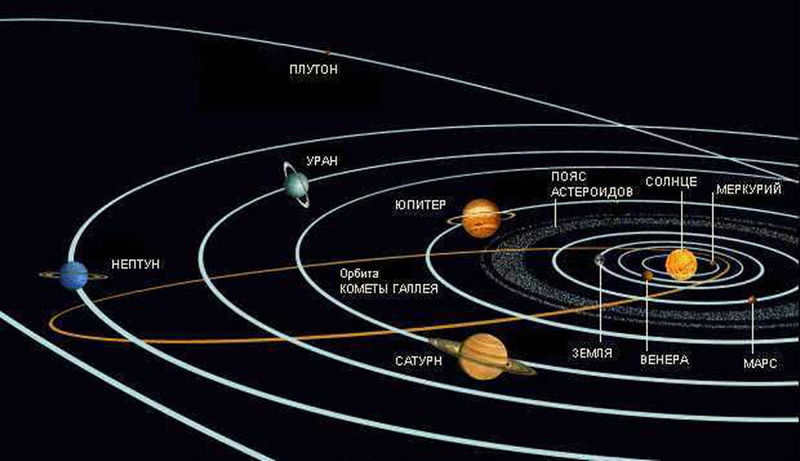
Neptune completes its first revolution since its discovery in 2011, which takes about 164.79 Earth years to complete a full orbit.
With an axial tilt of 28.32 0 , Neptune experiences seasons similar to Earth and Mars, but on a much slower timescale. Each season on Neptune lasts approximately 40 Earth years.
The rotation time of Neptune’s magnetic field is 16 hours, but due to its gaseous nature, the actual rotation rate varies at different latitudes. The widest equatorial belt takes 18 hours to rotate, while the middle and polar belts rotate at a faster pace. The circumpolar regions complete a revolution in 12 hours. This significant variation in rotation rate is more noticeable on Neptune compared to other planets.
The Structure and Surface of Neptune
Neptune is classified as an ice giant, along with its neighboring planet Uranus. The composition of Neptune is unique, with a rocky core consisting of silicates and metals located at its center. Surrounding the core is a mantle made up of methane ice, water, and ammonia. Finally, Neptune has an atmosphere composed of helium, hydrogen, and methane.
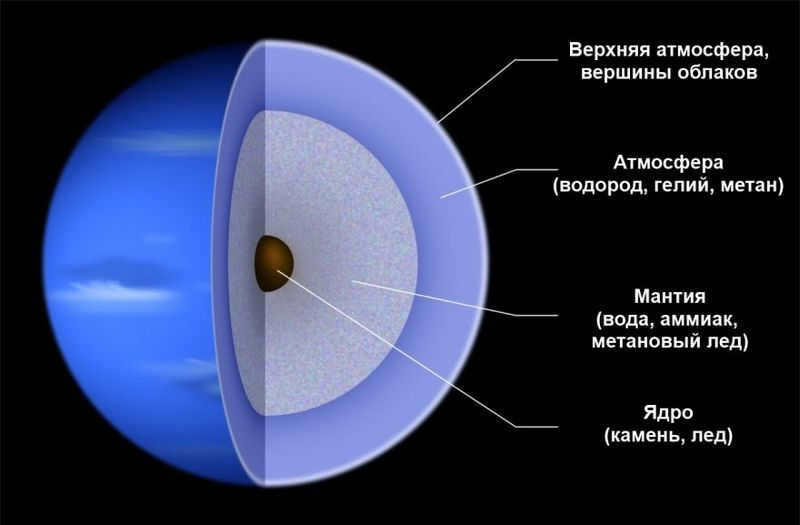
However, it should not be assumed that the mantle of Neptune consists of ice, a solidified liquid. In reality, the mantle is incredibly hot due to the immense pressure present. Temperatures range from 2000 to 5000 K, similar to the surface of the Sun. Despite this, the substance formed under such extreme pressures is still referred to as ice, although it is a highly dense and hot liquid primarily composed of ammonia. This unique state is known as hot ice.
There is a theory suggesting that at a depth of 7000 km, methane may transform into diamond crystals under the influence of tremendous pressure and temperature before eventually settling closer to the planet’s core. It is even possible that Neptune harbors a substantial layer rich in diamonds.
Neptune’s Atmosphere and Temperature
The uppermost layer of Neptune’s atmosphere is predominantly composed of hydrogen (80%) and helium (19%), with a small amount of methane mixed in. Methane is responsible for absorbing red light, resulting in the planet’s distinctive bluish hue. However, the same effect is less pronounced on Uranus, which appears blue, while Neptune retains its deep blue color. The exact reason for this discrepancy is not yet fully understood. It is hypothesized that there may be an additional component in Neptune’s atmosphere that strongly absorbs the red portion of the light spectrum.
In the higher region of the atmosphere, where there is a significant decrease in pressure, methane undergoes condensation and forms a series of clouds. As we descend, with the increase in pressure, the composition of the clouds changes to consist of hydrogen sulfide and ammonia. Further down, the clouds consist of ammonia, hydrogen sulfide, water, and ammonium sulfide. At a pressure of 50 bar and a temperature of approximately 0 degrees Celsius, the clouds are primarily composed of water ice.
Consequently, Neptune’s upper atmosphere contains a range of cloud types at varying altitudes. In the lower region, the atmosphere becomes cloudy due to the presence of methane decomposition products resulting from exposure to ultraviolet light.
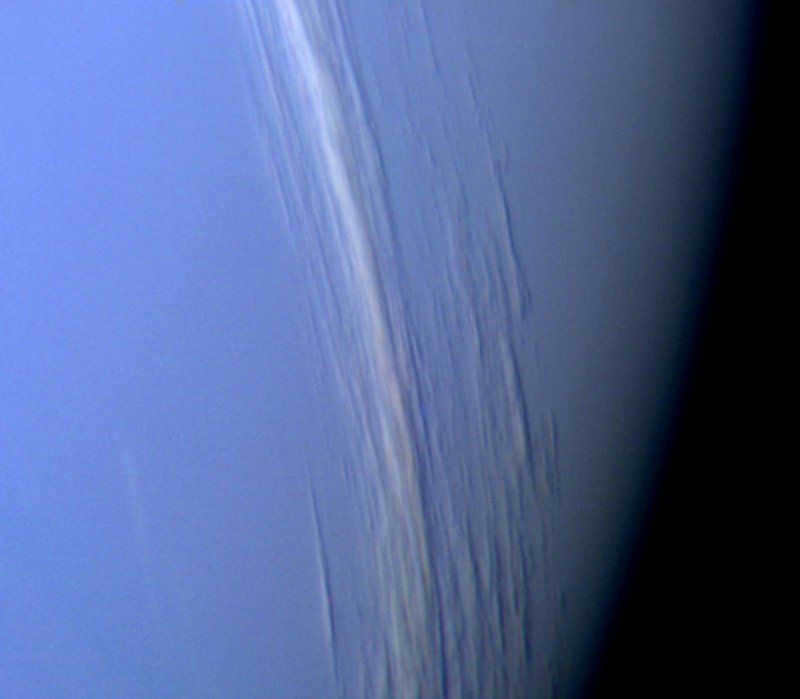
The vertical stratification of the clouds is clearly evident in this picture.
Neptune’s atmosphere features a layer known as the thermosphere, where the temperature reaches an unusually high 750 K. The reason for this remains unknown, considering that Neptune is much farther away from the Sun compared to Uranus, which does not experience such an effect. Despite receiving minimal solar heat, Neptune’s temperature rises significantly. It is possible that this heating is a result of gravity or the interaction between charged ions from the magnetosphere and atmospheric gases.
In contrast to Uranus, the atmosphere of Neptune experiences extremely powerful winds, reaching speeds of up to 600 m/s. These winds blow at varying velocities, with high latitudes following the planet’s rotation and low latitudes moving in the opposite direction.
Currently, the southern pole of Neptune experiences temperatures that are 10 degrees higher compared to the rest of the planet. As a result, methane is able to escape into space in this region, while in other areas it remains slightly colder and freezes. This occurrence is due to the fact that for the past four decades, Neptune’s south pole has been facing the Sun as a result of its axial tilt. When summer arrives in the northern hemisphere, the north pole will become the warmest point, causing methane to be released there.
The shifting seasons also impact the cloud bands in each hemisphere. At present, the southern hemisphere is experiencing warmer temperatures and a higher concentration of clouds. However, after 2020, a new season will commence, leading to changes in these patterns.
Back in 1989, when Voyager 2 was passing by Neptune, it managed to capture an extraordinary sight – a massive storm vortex stretching across 13000 x 6600 km. This remarkable phenomenon was given the name the Great Dark Spot due to its distinct darker hue. However, by 1994, the Hubble telescope was no longer able to detect its presence.
These storms tend to form beneath the cloud layer, which contributes to their darker appearance. While they may persist for several months before vanishing, some can also transform into cyclones even after losing their vibrant color.
Temperature of Neptune
One of the enigmas surrounding Neptune is its temperature. This celestial body is situated much farther away from the Sun compared to Uranus and receives 60% less sunlight. Nevertheless, Uranus emits 1.1 times more energy than it absorbs, while Neptune emits 2.61 times more!
The origin of this surplus energy in Neptune remains a mystery. There exist various hypotheses, ranging from radioactive heating of the planet’s core to chemical reactions occurring in the lower atmosphere, such as the conversion of methane into other hydrocarbons.
Neptune’s ring system
Similar to the ring systems of other gas giants, Neptune possesses a collection of rings. Composed primarily of ice and dust particles, these rings are extremely faint. The rings were initially detected by the Voyager 2 spacecraft. Due to their distance from Earth, they are not visible to observers on our planet.
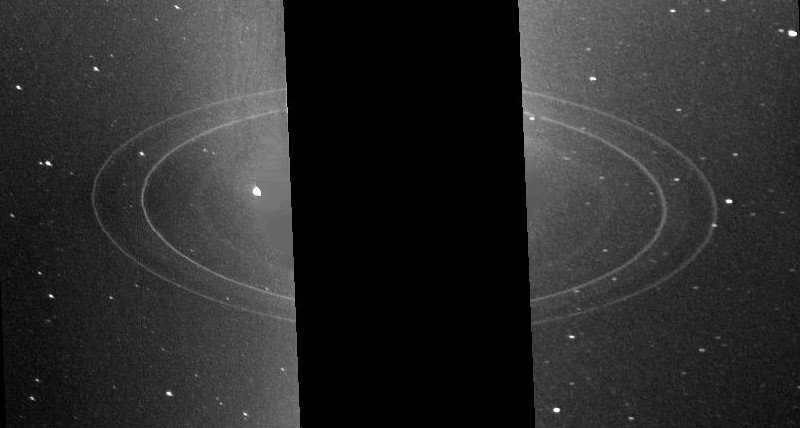
The Voyager 2 image shows the rings of Neptune.
Neptune possesses a total of 5 rings, which have been named in honor of the scientists who contributed to the planet’s exploration – Halle, Leverrier, Lassell, Arago, and Adams. Lassell’s ring is the widest, measuring 4,000 kilometers in width. Interestingly, this particular scientist also happened to discover Neptune’s moon Triton just 17 days following its initial detection.
In contrast, Leverrier’s ring, the one he himself discovered, is a mere 113 kilometers wide. The remaining rings are even narrower, with Adams’ ring being the slimmest at just 35 kilometers. However, despite its narrowness, Adams’ ring is also the most luminous.
Satellites of Neptune
Similar to other large planets, Neptune possesses a multitude of satellites. Currently, there are 14 known satellites orbiting Neptune. The most significant among them is Triton, with a diameter of approximately 2700 km. Triton primarily comprises ice, but it also contains a metallic core at its center. In terms of mass, Triton accounts for 95.5% of the total mass of Neptune’s satellites. Additionally, it is the only satellite of such magnitude that it has acquired a spherical shape.
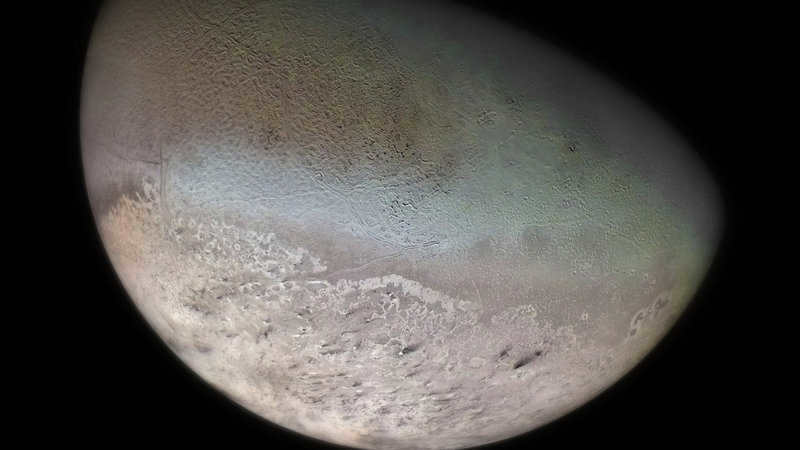

Triton, the moon of Neptune, holds the title of being the coldest moon in our entire Solar System. Its surface temperature is an astonishingly chilly 38 K, which is the equivalent of -235 degrees Celsius. This freezing temperature brings Triton close to absolute zero. Interestingly, Triton follows a spiral orbit that slowly brings it closer to Neptune. Scientists predict that this gradual approach will eventually lead to Triton’s destruction in a few tens of millions of years. If this happens, Neptune will end up with rings even larger than those of Saturn.
Triton is a fascinating moon with unique features. It stands out among other moons due to its tectonic activity. Cryovolcanoes can be found on its icy surface, and there is a possibility of an underwater ocean hidden beneath the frozen exterior.
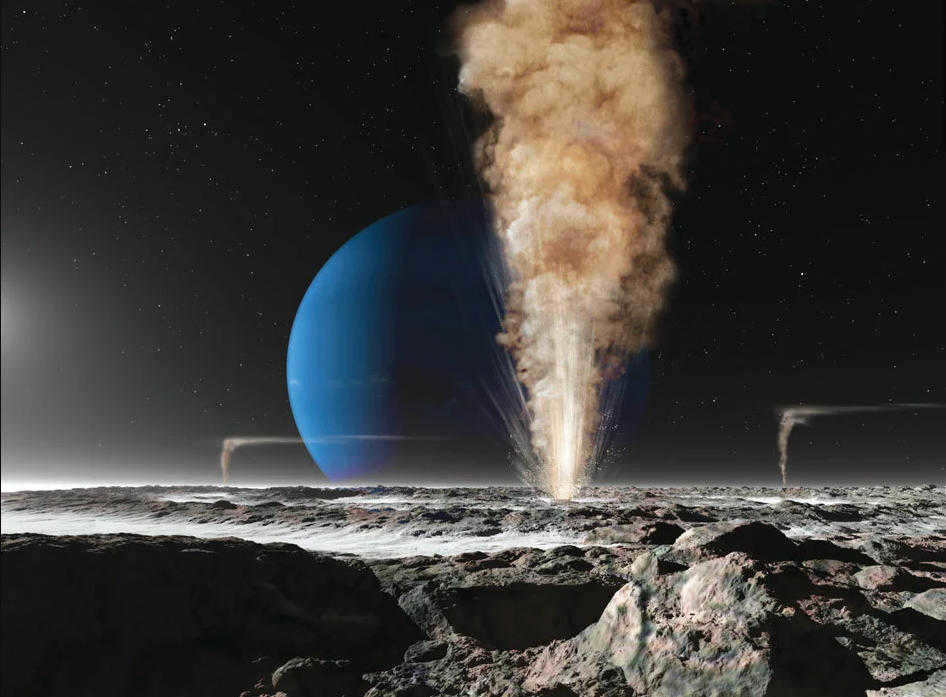
Triton possesses cryovolcanoes.
The other moons of Neptune resemble large asteroids. The most significant among them is Proteus, which showcases an irregular structure and measures 420 kilometers in diameter. The third largest is Nereid, spanning 340 kilometers. The remaining moons of Neptune are considerably smaller. Hippocampus, the tiniest satellite of the Neptune planet, was discovered in 2013 and measures a mere 18 kilometers in size.
Neptune and the Kuiper Belt
Stretching from about 30 a.u. to 55 a.u. from the Sun, the Kuiper belt is home to a significant concentration of minor planets. This region bears a resemblance to the asteroid belt located between Mars and Jupiter.
Playing a crucial role in the formation and structure of the Kuiper belt, the planet Neptune exerts a strong gravitational pull on its surroundings. Positioned near the edge of the Kuiper belt, Neptune has had a profound effect on shaping this region. Thanks to its gravitational influence, the orbits of many Kuiper Belt objects have achieved stability through orbital resonance with Neptune. Over the course of the solar system’s existence, Neptune has carefully organized the positioning of each object in this region.
The Study of Neptune: A Historical Perspective
Neptune, located at the farthest reaches of our solar system, poses unique challenges for scientific exploration due to its immense distance from Earth. To overcome this obstacle, researchers have relied heavily on the Hubble Space Telescope.
Among the various space probes sent to investigate Neptune, only one, Voyager 2, successfully reached its destination on August 25, 1989. This mission was of great significance, prompting scientists to modify the spacecraft’s trajectory to allow for a close encounter with Triton, despite the potential risks involved. Voyager 2 ultimately managed to approach Nereid, located 4,400 kilometers from Neptune’s atmosphere, before finally coming into close proximity with Triton. Remarkably, all of these events unfolded on the same momentous day.
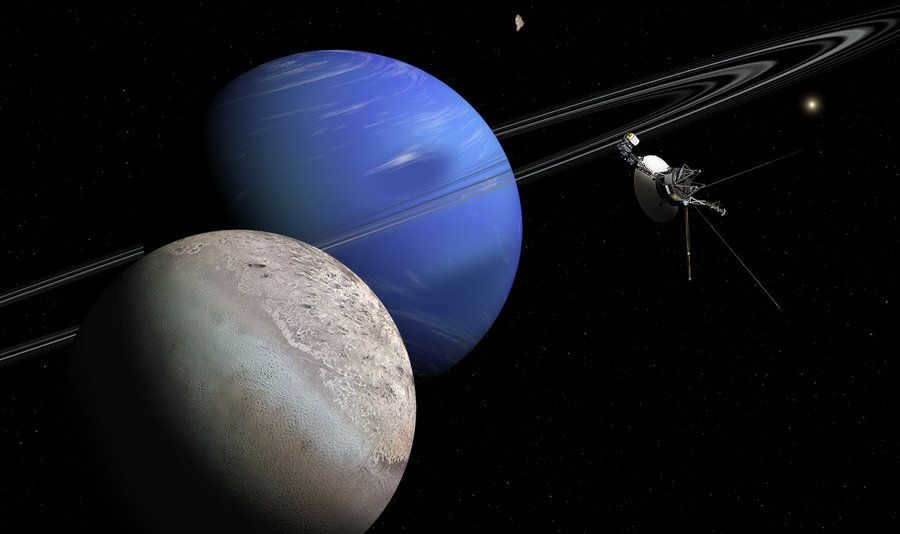

Voyager 2 was the sole spacecraft to explore Neptune.
Due to the immense distance, the signal transmitted to Voyager 2 took 246 minutes one way, resulting in the probe operating almost independently with pre-loaded programs. It successfully completed its mission and transmitted a wealth of scientific data and images. In fact, much of our knowledge about Neptune is owed to Voyager 2.
On August 25, 1989, the day of Voyager 2’s encounter with Neptune, there was even a nightly broadcast titled “Neptune All Night” featuring reports on the event.
In 2014, the New Horizons spacecraft crossed Neptune’s orbit, but it was in hibernation mode and its target was Pluto.
Currently, there are no intentions to send any spacecraft to Neptune. In 2016, NASA had plans to launch the Neptune Orbiter mission, but its future remains uncertain. The focus of exploration at present is on Uranus rather than Neptune.
Observing Neptune
The optimal time for observing Neptune is during the months of August and September. During this period, it reaches the opposition point and is at its closest distance to Earth. However, its brightness during this time is approximately 7.7m, rendering it invisible to the naked eye.
Neptune can be detected using 7×50 binoculars, but it will appear as a faint star within the Aquarius constellation.
There is a debate about which telescope is required to view Neptune as a disk rather than a star. Some amateurs claim to have seen the disk using an 80mm telescope, while others were unable to distinguish it with a 150mm reflector.
Neptune’s disk has an angular size in the sky ranging from 2 to 2.3″, which is quite small compared to the other planets in the solar system. Therefore, to confidently observe the planet’s disk, it is recommended to use a telescope with an aperture of at least 200-250mm and a magnification of 200x or higher.
However, even with a good view of this blue pea, it is not possible to see any details on the planet. Even telescopes with apertures of 400mm or more only reveal variations in brightness on the surface and a darkening of the disk towards the edges.

